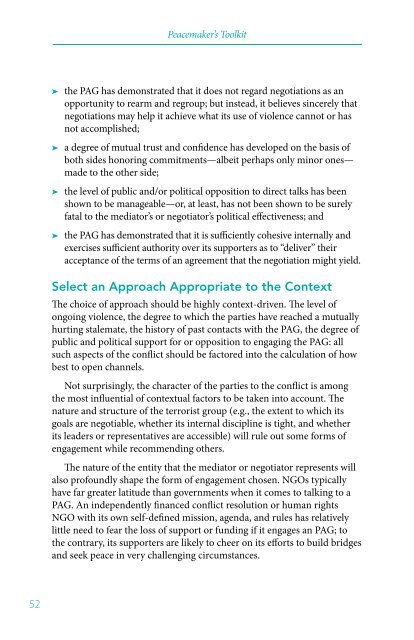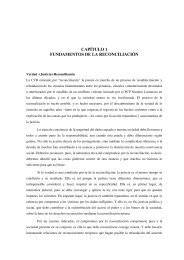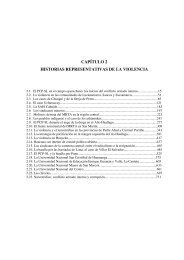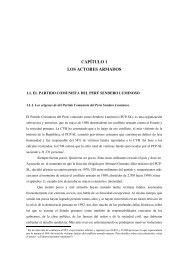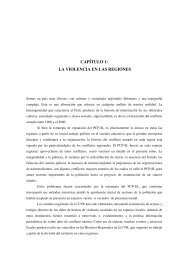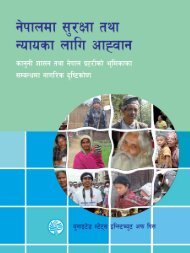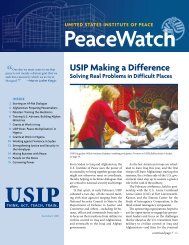Talking to Groups that Use Terror.pdf - United States Institute of Peace
Talking to Groups that Use Terror.pdf - United States Institute of Peace
Talking to Groups that Use Terror.pdf - United States Institute of Peace
Create successful ePaper yourself
Turn your PDF publications into a flip-book with our unique Google optimized e-Paper software.
<strong>Peace</strong>maker’s Toolkit➤➤➤➤➤➤➤➤the PAG has demonstrated <strong>that</strong> it does not regard negotiations as anopportunity <strong>to</strong> rearm and regroup; but instead, it believes sincerely <strong>that</strong>negotiations may help it achieve what its use <strong>of</strong> violence cannot or hasnot accomplished;a degree <strong>of</strong> mutual trust and confidence has developed on the basis <strong>of</strong>both sides honoring commitments—albeit perhaps only minor ones—made <strong>to</strong> the other side;the level <strong>of</strong> public and/or political opposition <strong>to</strong> direct talks has beenshown <strong>to</strong> be manageable—or, at least, has not been shown <strong>to</strong> be surelyfatal <strong>to</strong> the media<strong>to</strong>r’s or negotia<strong>to</strong>r’s political effectiveness; andthe PAG has demonstrated <strong>that</strong> it is sufficiently cohesive internally andexercises sufficient authority over its supporters as <strong>to</strong> “deliver” theiracceptance <strong>of</strong> the terms <strong>of</strong> an agreement <strong>that</strong> the negotiation might yield.Select an Approach Appropriate <strong>to</strong> the ContextThe choice <strong>of</strong> approach should be highly context-driven. The level <strong>of</strong>ongoing violence, the degree <strong>to</strong> which the parties have reached a mutuallyhurting stalemate, the his<strong>to</strong>ry <strong>of</strong> past contacts with the PAG, the degree <strong>of</strong>public and political support for or opposition <strong>to</strong> engaging the PAG: allsuch aspects <strong>of</strong> the conflict should be fac<strong>to</strong>red in<strong>to</strong> the calculation <strong>of</strong> howbest <strong>to</strong> open channels.Not surprisingly, the character <strong>of</strong> the parties <strong>to</strong> the conflict is amongthe most influential <strong>of</strong> contextual fac<strong>to</strong>rs <strong>to</strong> be taken in<strong>to</strong> account. Thenature and structure <strong>of</strong> the terrorist group (e.g., the extent <strong>to</strong> which itsgoals are negotiable, whether its internal discipline is tight, and whetherits leaders or representatives are accessible) will rule out some forms <strong>of</strong>engagement while recommending others.The nature <strong>of</strong> the entity <strong>that</strong> the media<strong>to</strong>r or negotia<strong>to</strong>r represents willalso pr<strong>of</strong>oundly shape the form <strong>of</strong> engagement chosen. NGOs typicallyhave far greater latitude than governments when it comes <strong>to</strong> talking <strong>to</strong> aPAG. An independently financed conflict resolution or human rightsNGO with its own self-defined mission, agenda, and rules has relativelylittle need <strong>to</strong> fear the loss <strong>of</strong> support or funding if it engages an PAG; <strong>to</strong>the contrary, its supporters are likely <strong>to</strong> cheer on its efforts <strong>to</strong> build bridgesand seek peace in very challenging circumstances.52


